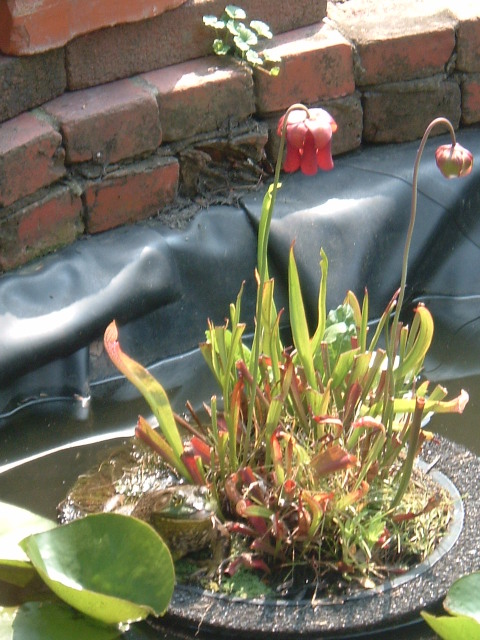Question 728 floater
728 floater
QUESTION: i have succeeded in the floating CP container in my pond
now i want to enlarge it to a CP bog garden
i have a 35 gallon 'water garden' fiberglass type container
i'm reading that FULL sun is best, the hole i dug gets PART sun, i will dig another hole, but you are the specialists you tell me
i live in western Maryland, i want all varieties, but probably the Sarracenia will fair better (as they have in my floating pond containers
ANSWER: Hi Terri,
Is that really a frog on your floating island? Nice! We have Pacific tree frogs that colonize amongst our Sarracenia pools.
We really encourage growers to grow their Sarracenia in full sun (6 or more hours of direct sunlight). With this type of lighting, you will see the full potential of these plants. Partial sunlight (4-6 hours of direct sunlight) is acceptable, but you'll miss out on some of the deeper colors on certain varieties. If you provide just the bare minimum, four hours of direct sun, you may get some lanky growth. I can certainly understand that if you positioned your bog garden in an area because of aesthetics, but you have to decide if it's worth it to have plants that might not be reaching their full potential. This might be OK if your bog garden will have other plants that grow fine in partial sun. That will take the full attention off of the Sarracenia. But if the bog garden is going to feature the Sarracenia, you should consider positioning it in full sun.
On another note, go ahead and trim off the older leaves on your pitcher plant. That way the new growth will get maximum sunlight.
Good growing!
Jacob Farin
---------- FOLLOW-UP ----------
QUESTION: yes i have cut back older leaves
yes that is "Bullie" who left us this year...
don't know why i thot we provided a nice home for him, which included floating rafters!
i did FORGET to ask... should i poke holes in the bottom of the fiberglass "pond"?
and i will look for another location, because i want to see the wonderful attributes these plants have
thanks for your time
when i get things ready will be back to order
and the DVD is GREAT!~
ANSWER: There are two ways to go about the drainage holes. You could either bore the holes on the flat bottom or you could do so on the sides, just an inch or two above the bottom.
If you choose to bore the holes on the bottom, you'll have to pay attention to moisture level much more carefully, especially during the hottest parts of summer. Essentially what you'll have is a very large pot placed in the ground, so water will drain out very quickly. If you incorporate an automatic drip or watering system, problem solved. You will also need to place a layer of sand UNDER the fiberglass pond so that water can drain out and not absorb soil nutrients into the bog garden.
If you choose to bore the holes on the sides, you will have a small reservoir of water at the bottom of the bog garden. This will help keep the bog consistently damp. However, there is greater risk for soil nutrients to leach in, so you'll need to incorporate a perimeter of sand surrounding the bog garden.
(We recently built an above-ground bog garden. Frankly, me and shovels don't get along.)
Good growing!
Jacob Farin
---------- FOLLOW-UP ----------
QUESTION: sounds like it would be better to NOT put holes in bottom!
what about having a nice layer of lava rock in the bottom?
sorry for all the questions but my only luck with CP's have been in the floating container and i REALLY want to expand!
AnswerIf you put the holes on the sides, you'll need a layer of sand between the garden soil and the liner of your pond. From the outside in, you'll have garden soil, sand, pond liner and then bog soil. The sand layer should be about 3 inches thick all around the pond and underneath the pond, so take this into consideration when you dig your hole. Make the hole a bit larger than the pond liner. Once you get your hole dug, fill the bottom with sand, and then place the liner in the hole. Next, fill in the gaps with sand. This will allow water to drain out of the bog without flowing back in the bog. You can cover the sand gap with flat rocks around the bog.
In your pond liner, you can also place a layer of lava rock that goes up to the drain holes. This will increase the amount of water in the reservoir.
Good growing!
Jacob Farin






